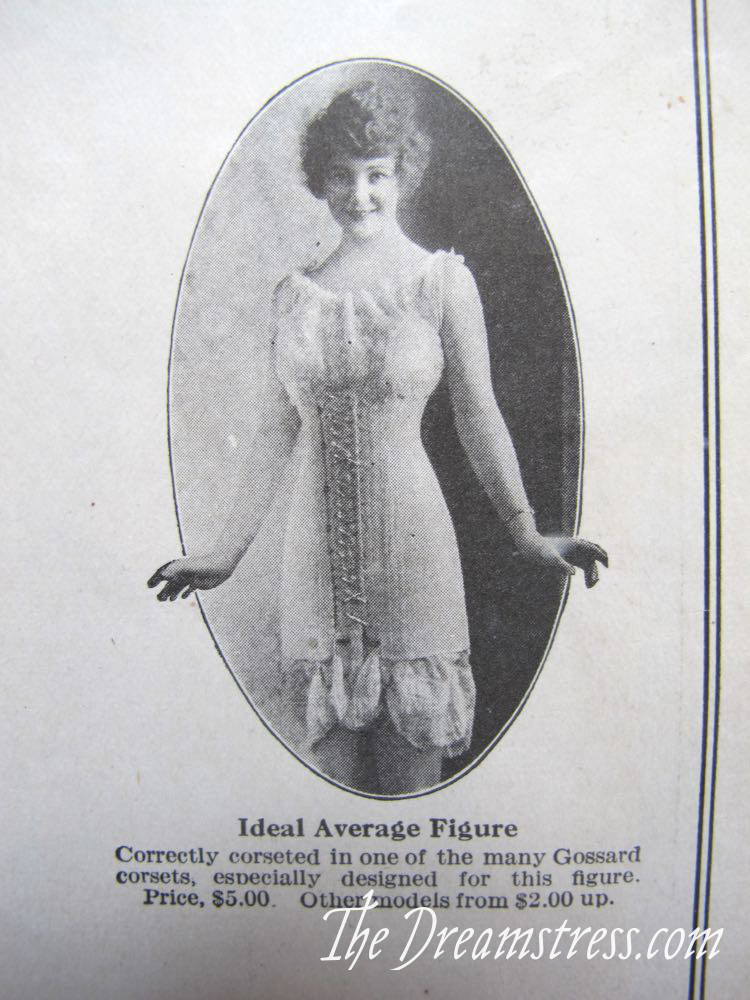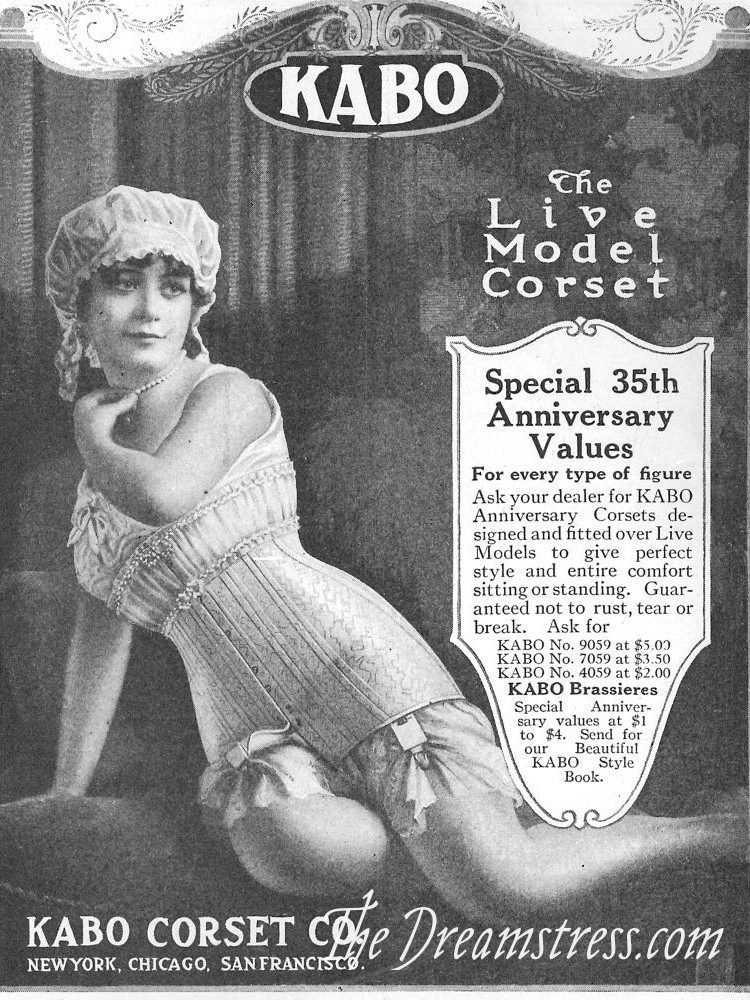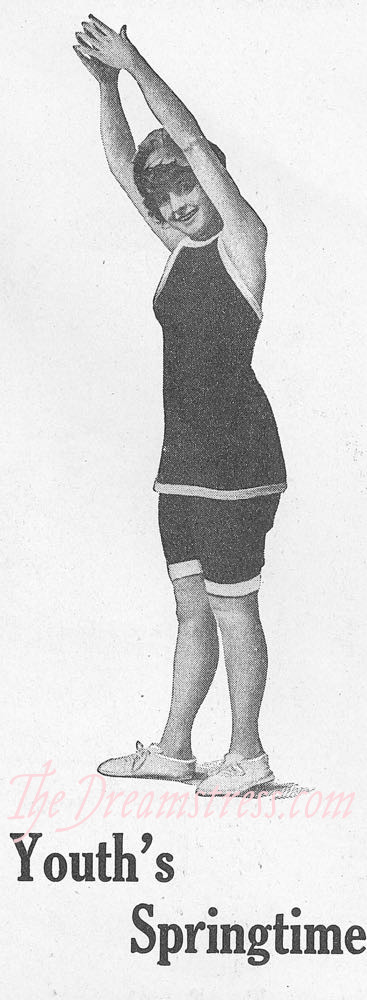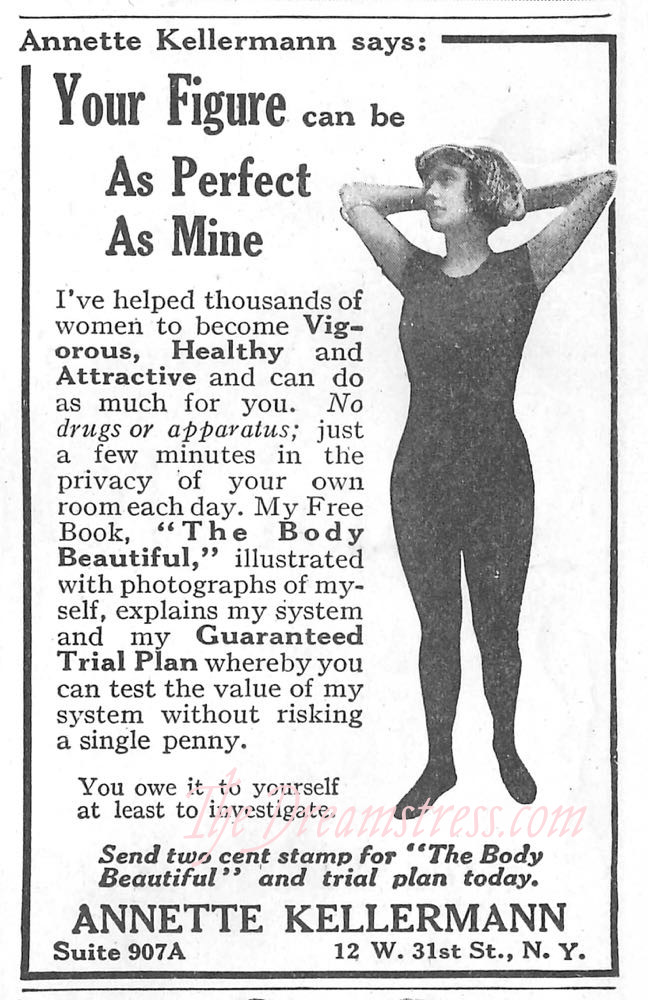I started my series on the fashionable ideal of the figure in the WWI era (specifically 1913 to 1921, the years covered by the Scroop Rilla Corset) with a look at a Gossards Corset ad which showed a whole variety of ‘ideal’ figures:
While these figures look diverse, they all have some traits in common, so let’s look at what they are.
The fashionable figures shown in magazines and advertising ca. 1916, whether they are tall or short, large or small, all tend to feature the following:
- Low, moderately full busts (larger at the start of WWI, reducing as the war progresses)
- Small but not tiny or exaggerated waists
- Full, sloping bottoms, with the fullness quite low (as opposed to the modern fashion, which tends to favour high, pert bottoms).
I call the WWI figure a ‘slight hourglass’ – with a gentle transition from bust to waist to hips, rather than the extreme curves of the early Edwardian era.
Here is the low, full bust:
Notice how much lower the bust sits compared to where it would sit when held with a modern bra, and how little support the chemise provides. Notice also how full the bust is: that’s not a B cup!
This same line is echoed in the fashionable dress of the time, even in illustrations of dress for young girls:
At the start of the war the slimmer skirts of the early 1910s were still in fashion, so there was still emphasis on slim hips to match, but by 1915 the skirts began to widen, so hip size became inconsequential.
Some corset advertisements, like Gossards, still regularly showed fairly slim hipped figures as their ‘average’ figure:
But many others showed figures that were proportionally much curvier – a rather lovely demonstration that there has always been variety in the ideal, and that even in advertising the ‘perfect’ figure depended on the brand, the taste of the photographer or illustrator, and the final selection of the editor:
And photograph advertisements which depict women with the ideal figures of the time in knit combinations or swimsuits show quite definite hips and bottom curves:
Notice the low, full bust again.
This one shows a youthful figure, so the bust is smaller, but the waist definition and low-angled bottom are clearly visible.
The full, low bottom was a carry-on from the early 1910s fashion for clinging frocks which cascaded off the angle of the bottom:
One of the women most known for her figure throughout the 1900s & 1910s was swimmer and actress Annette Kellermann, famous for popularising the one-piece swimsuit.
Kellermann sold programmes for developing the perfect body throughout the 1910s, and used her own as the ‘ideal’ model, giving us a very good idea of what was considered desirable in a body:
Next up in the series (after a little break for Rate the Dress and some of my sewing), a look at the way the fashionable figure ideal changed from 1913 to 1921.












Thank you! I’m working on the Rilla corset just now, as well as some 1910s pieces and these posts are great and very helpful.
I was born at the wrong time! (1957) I have the 1910 ideal figure. So did my mother, born 1928, and her mother born 1883, married in 1909. Darn! Maybe I should be like Tasha Tudor (author, illustrator) and live as if it were the era I have the ideal figure for. Thanks for this fascinating look at the early twentieth century. I really love the fashions from that era.
Well that is my exact figure. I guess I should do more with this era!
Wow, I love that Anna Kellerman ad! It’d be really interesting to see what she advises. I wonder if it was really her own exercise regimen, or if it was a gimmick.
This post explains so much, and even makes me like pigeon front blouses, better, since I have only pictured or imagined them on hoiked-up boobs and could see how they would look lovely on a lower-breasted figure that became the ideal in the teens. Of course, now that I see it, I cannot unsee it. As in ‘so THAT’S how she looks so good in that!’
And I am going to reply to myself. I keep thinking about the fact that clothing from 1900-1940,was all about working with gravity, while 1940 till now is all about working against gravity. Somehow, I feel that this is profound. And newly discovered. AL because of your post.
I think some of that is the shift from maturity to youth as an ideal. Mature adults have gravity weigh upon them. Youth stereotypically doesn’t.